Intel’s Tiger Lake 11th Gen Core i7-1185G7 Review and Deep Dive: Baskin’ for the Exotic
by Dr. Ian Cutress & Andrei Frumusanu on September 17, 2020 9:35 AM EST- Posted in
- CPUs
- Intel
- 10nm
- Tiger Lake
- Xe-LP
- Willow Cove
- SuperFin
- 11th Gen
- i7-1185G7
- Tiger King
CPU Performance: Office and Web
Our previous set of ‘office’ benchmarks have often been a mix of science and synthetics, so this time we wanted to keep our office section purely on real world performance.
Agisoft Photoscan 1.3.3: link
Photoscan stays in our benchmark suite from the previous benchmark scripts, but is updated to the 1.3.3 Pro version. As this benchmark has evolved, features such as Speed Shift or XFR on the latest processors come into play as it has many segments in a variable threaded workload.
The concept of Photoscan is about translating many 2D images into a 3D model - so the more detailed the images, and the more you have, the better the final 3D model in both spatial accuracy and texturing accuracy. The algorithm has four stages, with some parts of the stages being single-threaded and others multi-threaded, along with some cache/memory dependency in there as well. For some of the more variable threaded workload, features such as Speed Shift and XFR will be able to take advantage of CPU stalls or downtime, giving sizeable speedups on newer microarchitectures.
For the update to version 1.3.3, the Agisoft software now supports command line operation. Agisoft provided us with a set of new images for this version of the test, and a python script to run it. We’ve modified the script slightly by changing some quality settings for the sake of the benchmark suite length, as well as adjusting how the final timing data is recorded. The python script dumps the results file in the format of our choosing. For our test we obtain the time for each stage of the benchmark, as well as the overall time.
The final result is a table that looks like this:
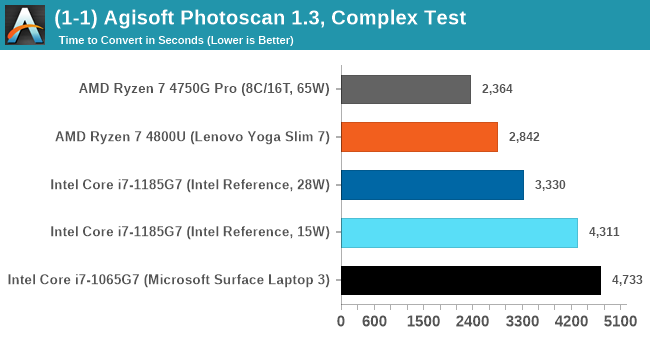
As explained in the power tests, the 4800U with double the cores wins out here, and due to the vector pressure also wins on power efficiency. There’s still a sizeable uplift from Ice Lake to Tiger Lake at 15 W, although 28 W is needed to get something sizeable.
Mozilla Kraken 1.1
Kraken is a 2010 benchmark from Mozilla and does a series of JavaScript tests. These tests are a little more involved than previous tests, looking at artificial intelligence, audio manipulation, image manipulation, json parsing, and cryptographic functions. The benchmark starts with an initial download of data for the audio and imaging, and then runs through 10 times giving a timed result.
Automation involves loading the direct webpage where the test is run and putting it through. All CPUs finish the test in under a couple of minutes, so we put that as the end point and copy the page contents into the clipboard before parsing the result. Each run of the test on most CPUs takes from half-a-second to a few seconds.
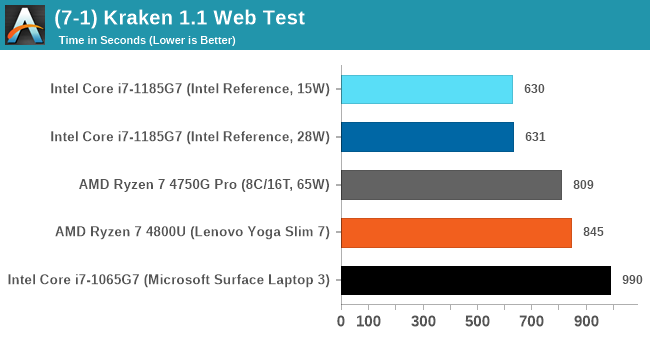
Both the Tiger Lake results are very fast, not showing much difference between the power modes. Intel pushes ahead of AMD here, and ultimately a sizable jump over Ice Lake.
Google Octane 2.0
Our second test is also JavaScript based, but uses a lot more variation of newer JS techniques, such as object-oriented programming, kernel simulation, object creation/destruction, garbage collection, array manipulations, compiler latency and code execution.
Octane was developed after the discontinuation of other tests, with the goal of being more web-like than previous tests. It has been a popular benchmark, making it an obvious target for optimizations in the JavaScript engines. Ultimately it was retired in early 2017 due to this, although it is still widely used as a tool to determine general CPU performance in a number of web tasks.
Octane’s automation is a little different than the others: there is no direct website to go to in order to run the benchmark. The benchmark page is opened, but the user has to navigate to the ‘start’ button or open the console and initiate the JavaScript required to run the test. The test also does not show an obvious end-point, but luckily does try and aim for a fixed time for each processor. This is similar to some of our other tests, that loop around a fixed time before ending. Unfortunately this doesn’t work if the first loop goes beyond that fixed time, as the loop still has to finish. For Octane, we have set it to 75 seconds per run, and we loop the whole test four times.
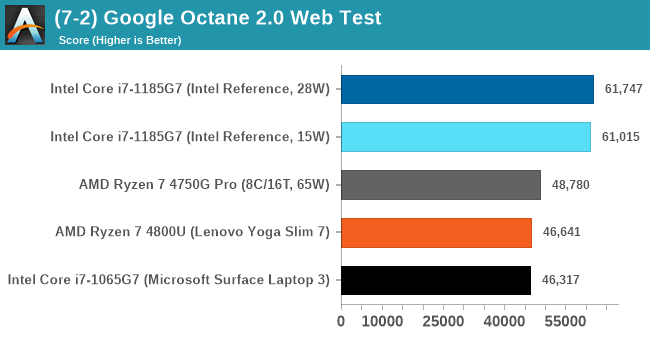
The Tiger Lake system reaches new records in Optane. If there’s anything this system is fast at, it is web workloads.
Speedometer 2: JavaScript Frameworks
Our newest web test is Speedometer 2, which is a test over a series of JavaScript frameworks to do three simple things: built a list, enable each item in the list, and remove the list. All the frameworks implement the same visual cues, but obviously apply them from different coding angles.
Our test goes through the list of frameworks, and produces a final score indicative of ‘rpm’, one of the benchmarks internal metrics. Rather than use the main interface, we go to the admin interface through the about page and manage the results there. It involves saving the webpage when the test is complete and parsing the final result.
We repeat over the benchmark for a dozen loops, taking the average of the last five.
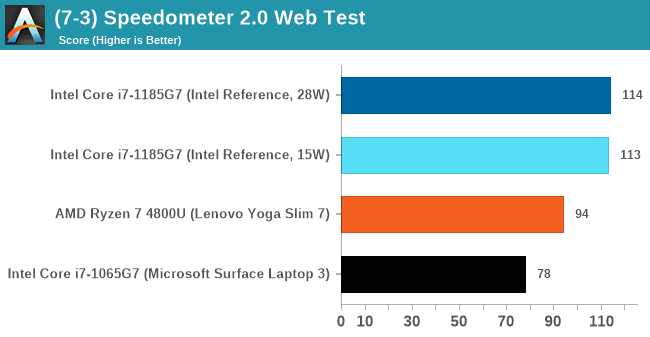
Again, another good win for Tiger Lake.


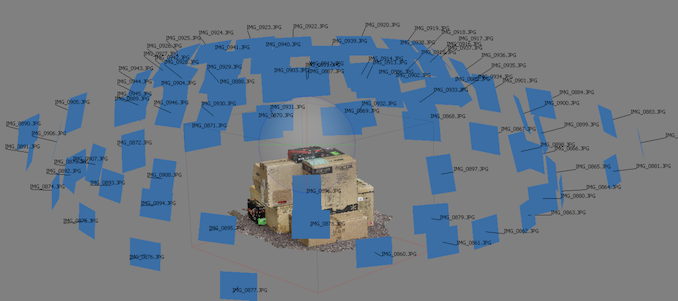
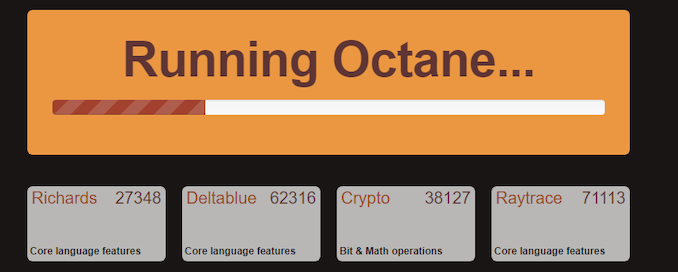
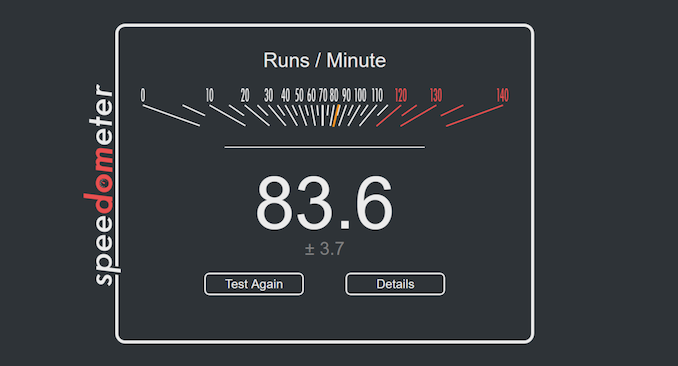








253 Comments
View All Comments
MDD1963 - Saturday, September 19, 2020 - link
Although equaling/exceeding 7700K-level of performance within a 50W envelope in a laptop is impressive, the 4c/8t design is going to cause at least one or two frowns/raised eyebrows...ballsystemlord - Saturday, September 19, 2020 - link
@Ian why do these companies always seem to have the worst timing on sending you stuff? Do you tell them when you'll be on vacation?Thanks for the review!
Ian Cutress - Sunday, September 20, 2020 - link
It's happened a lot these past couple of years. The more segments of the tech industry you cover, the less downtime you have - my wife obviously has to book holiday months in advance, but companies very rarely tell you when launches are, or they offer surprise review samples a few days before you are set to leave. We do our best to predict when the downtime is - last year we had hands on with the Ice Lake Development system before the announcement of the hardware, and so with TGL CPUs being announced first on Sep 2nd, we weren't sure when the first units were coming in. We mistimed it. Of course with only two/three of us on staff, each with our own segments, it's hard to get substitutes in. It can be done, Gavin helped a lot with TR3 for example. But it depends on the segment.And thanks :)
qwertymac93 - Sunday, September 20, 2020 - link
Finally a decent product from Intel. It's been a while. Those AVX512 numbers were impressive. Intel is also now able to compete toe to toe with AMD integrated graphics, trading blows. I feel that won't last, though. AMD is likely to at least double the GPU horsepower next gen with the move from a tweaked GCN5 to RDNA2 and I don't know if Intel will be able to keep up. Next year will be exciting in any case.Spunjji - Sunday, September 20, 2020 - link
It'll be a while before we get RDNA2 at the high end - looks like late 2021 or early 2022. Before that, it's only slated to arrive with Van Gogh at 7-15Wefferz - Monday, September 21, 2020 - link
It is very interesting to see that the intel complier make the SPECint2017 scores 52% higher than other compliers without 462.libquantum.helpMeImDying - Thursday, September 24, 2020 - link
Hello, before ranting I want to know if the scores of spec2006 and spec2017 were adjusted/changed based on processors frequency(Read something like that in the article)? Because you can't do that. Frequencies should be out of the topic here unless comparing same generation CPU's and even then there are some nuances. What matters is the performance per watt comparing low power notebooks. It can be done mathematically, if the TDP can't be capped at the same level all the time, like you did in the first few pages. I'm interested in scores at 15W and 25W. So you should have and should in the future monitor and publish power consumed numbers near the scores.And if you are adjusting scores based on CPU frequencies, then they are void and incorrect.
helpMeImDying - Thursday, September 24, 2020 - link
Btw, same with iGPUs.beggerking@yahoo.com - Friday, September 25, 2020 - link
none of the tests seem valid... some are intel based others are AMD based... I don't see a single test where Ryzen beats 10th gen but loses to 11th gen on standard 15 watt profile...the speed difference between 10th and 11th gen intel is approx 10-15%.. its good, but probably not worth the price premium since Ryzen is already cheaper than 10th gen, i don't see how 11th gen would go cheaper than Ryzen...
legokangpalla - Monday, September 28, 2020 - link
I always thought AVX-512 was a direct standoff against heterogenous computing.I mean isn't it a better idea to develop better integrations for GPGPU like SYCL, higher versions of OpenCL etc? Programming with vector instructions IMO is lot more painful compared to writing GPU kernels and tasks like SIMD should be offloaded to GPU instead being handled by CPU instruction(CPU instruction with poor portability).